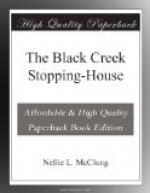The Black Creek Stopping-House gave not only food and shelter to the men who teamed the wheat to market—it gave them good fellowship and companionship. In the absence of newspapers it kept its guests abreast with the times; events great and small were discussed there with impartial deliberation, and often with surprising results. Actions and events which seemed quite harmless, and even heroic, when discussed along the trail, often changed their complexion entirely when Mrs. Maggie Corbett let in the clear light of conscience on them, for even on the very edge of civilization there are still to be found finger-posts on the way to right living.
Mrs. Maggie Corbett was a finger-post, and more, for a finger-post merely points the way with its wooden finger, and then, figuratively, retires from the scene to let you think it over; but Maggie Corbett continued to take an interest in the case until it was decided to her entire satisfaction.
Black Creek, on whose wooded bank the Stopping-House stands, is a deep black stream which makes its way leisurely across the prairie between steep banks. Here and there throughout its length are little shallow stretches which show a golden braid down the centre like any peaceful meadow brook where children may with safety float their little boats, but Black Creek, with its precipitous holes, is no safe companion for any living creature that has not webbed toes or a guardian angel.
The banks, which are of a spongy black loam, grow a heavy crop of coarse meadow grass, interspersed in the late summer with the umbrella-like white clusters of water hemlock.
* * * * *
About a mile from the Stopping-House there stood a strange log structure, the present abode of Reginald and Randolph Brydon, late of H.M. Navy, but now farmers and homesteaders. The house was built in that form of architecture known as a “Red River frame,” and the corners were finished in the fashion called “saddle and notch.”
Whatever can be done to a house to spoil its appearance had been done to this one. There was a “join” in each side, which was intended, and a bulge which was accidental, and when the sailor brothers were unable to make a log lie comfortably beside its neighbor by using the axe, they resorted to long iron spikes, and when these split the logs, as was usually the case, they overcame the difficulty by using ropes.
What had brought the Brydon brothers to Manitoba was a matter of conjecture in the Black Creek neighborhood. Some said they probably were not wanted at home; others, with deeper meaning, said they probably were wanted at home; and, indeed, their bushy eyebrows, their fierce black eyes, the knives which they carried in their belts, and their general manner of living, gave some ground to this insinuation.




